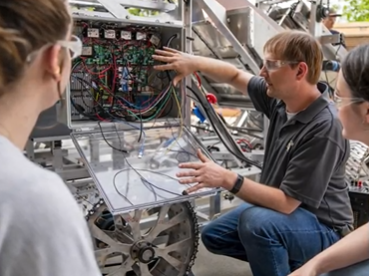SDSU Ready for NASA’s ‘Break the Ice’ Lunar Competition

Published Aug. 7 by Renee Ortiz from Keloland.
BROOKINGS, S.D. (KELO) — Surviving someplace other than Earth sounds like a sci-fi movie but students and staff at SDSU’s College of Engineering are working on a project that might make that possible.
“It has been a weird feeling to wake up every morning and go work on rovers for the day,” said Carter Waggoner, Mechanical Engineering Student.
Two years ago, Mechanical Engineering Professor Todd Letcher applied for NASA’s ‘Break the Ice’ Lunar Competition. A worldwide engineering contest.
“It’s a stepping-stone to get people to live on Mars eventually. But to do that, we’re going to learn how to live on the moon first. And one of the biggest challenges of living on the Moon is that you need large quantities of water for people to survive,” said Todd Letcher, Associate Professor in Mechanical Engineering.
This is why Letcher and his team “Space Trajectory” have been working on designing and building a rover which they call “The Excavator”.
“These robots that will harvest ice crystals from the south pole of the moon, those ice crystals will be removed from the soil, and dehydrated out of the soil, and then eventually be able to be used by the people,” Letcher said.
Letcher and his students have spent over 12 hours a day here since the beginning of summer building and perfecting their space rover in the hopes that one day it could be on the moon.
“It’s going to excavate material, store about 100 pounds of material onboard. And then it raises that material up and tips it into a dump truck. And the dump truck carries it away to the ice dehydration station,” Letcher said.
Carter Waggoner and Allea Klauenberg have been a part of the project since day one.
“We have a lot of engineering classes that we take but none of them are building a rover. So that’s definitely been my favorite part. Just designing it all and then seeing it come together and then working with some of these people,” said Allea Klauenberg, Mechanical Engineering Student.
The team is competing for a spot amongst 14 other aerospace teams.
“After doing this once, there’s so many things we’d love to change and redesign it would be a great process take our knowledge we have now and create a whole new rover,” Waggoner said.
Space Trajectory says they will continue working to bring their rover to the surface of the moon.
Letcher says the top four teams will move on to phase three of the project. The top four teams will take their rovers to the finals at the NASA head facility in Florida.
If the team makes it there, they will be able to test their rover’s design in NASA’s simulated lunar pits.
 National Science Foundation RII Track-1 Project:Expanding Research, Education and Innovation in South Dakota
National Science Foundation RII Track-1 Project:Expanding Research, Education and Innovation in South Dakota